Top 13 Most Creepy Mysteries That Have Finally Been Explained
 |
| Photo: KnowInsiders.com |
| Contents |
Some mysteries are no longer mysteries. Many previous mysteries have been solved by investigators because of scientific instruments that may not have existed at the time of the events. Sometimes a deathbed confession or a clue that everyone else missed gives the researchers just a stroke of luck.
However, sometimes the evidence is not taken seriously, especially if it is a disappointingly straightforward explanation devoid of any exotica. Novels and television programs might continue to search for hints to a "mystery" that never exists.
Top 13 Most Creepy And Mysterious Places That Have Finally Been Explained
1. The Bermuda Triangle
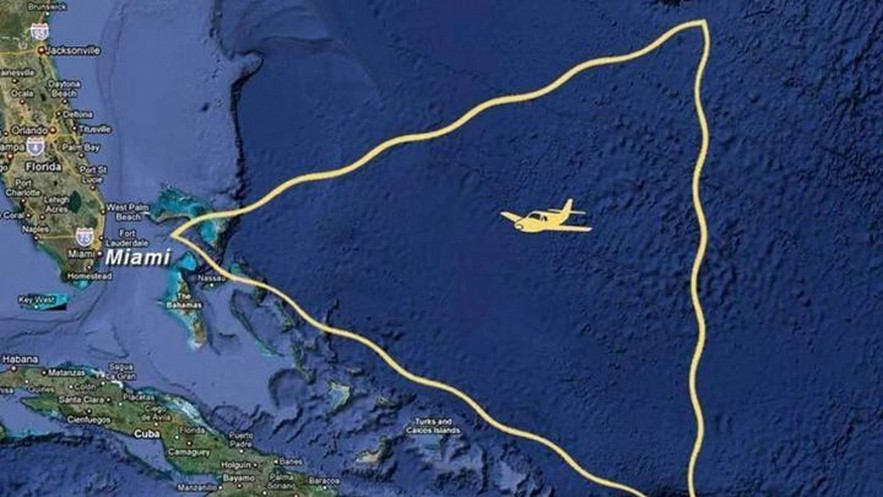 |
| Photo AS USA |
Where is Bermuda Triangle?
The Devil's Triangle, sometimes referred to as the Bermuda Triangle, is one of the world's most enigmatic locations. Situated in the Atlantic Ocean, between Bermuda, Florida, and Puerto Rico, off the US southeast coast, this area has emerged as a hub for unsolved mysteries.
The Bermuda Triangle, which stretches across 440,000 miles of ocean, is a major shipping route. Every day, a number of ships travel through it on their way to the United States, Europe, and the Caribbean.
What are Bermuda Triangle’s creepy mysteries?
Numerous aircraft and ships have reportedly mysteriously vanished in the area over the ages.
In addition, thousands of people's disappearances over the previous few decades have been attributed to the Devil's Triangle.
The legend surrounding the Bermuda triangle dates back to Christopher Columbus's first voyage to the New World, when it is said that he witnessed a flame from a fire smashing into the sea in the triangle.
The USS Cyclops, a Navy cargo ship carrying over 300 people, disappeared in the Bermuda Triangle in the 20th century, bringing the region's strange behavior to the attention of the general public. The disappearance of a small twin-engine plane in May of this year is the most recent incident in the area.
When the plane, carrying four people, abruptly vanished from the radar while it was traveling from Puerto Rico to Florida, its wreckage was eventually discovered.
The most recent ship-related incident occurred in October 2015 when a cargo ship sank in the Bermuda Triangle amid a catastrophic hurricane.
Numerous theories have been put forth to explain the mystery surrounding the frequently unexplained accidents that continue to occur in the Bermuda Triangle area.
| What is not known about the Bermuda Triangle: It is unknown how many ships and aircraft have vanished in the Bermuda Triangle. The most widely used estimate is 20 aircraft and 50 ships. Many ships and aircraft that were reported missing in the area have left their wreckage unrecovered. It's unclear if weather phenomena or human error is to blame for disappearances in the Bermuda Triangle. |
What has been explained about the ship and people’s appearance?
Because the Bermuda Triangle is a busy area of the sea, disappearances there are common, according to Kruszelnicki (he mentions the area's closeness to the United States).
In 2017, Kruszelnicki stated to news.com.au, "There is a lot of traffic because it is close to the Equator and a wealthy region of the world, America.The US Coast Guard and Lloyd's of London claim that the percentage of missing persons in the Bermuda Triangle is the same as that of any other place in the world."
Kruszelnicki also spoke about the most well-known disappearance associated with the triangle, Flight 19.
On December 5, 1945, Flight 19, consisting of five aircraft, departed from Fort Lauderdale, Florida, carrying fourteen crew members.
During a routine two-hour training flight, the US Navy's TBM Avenger torpedo bombers lost contact with the base. The crews of the planes disappeared, and no debris was ever found.
The 13 crew members on board as well as a PBM-Mariner seaplane that was sent on a search and rescue mission to find Flight 19 are said to have disappeared.
After 70 years of intense speculation, an Australian scientist has declared that the Bermuda Triangle mystery has been "solved," claiming that there was never a mystery to begin with.
Karl Kruszelnicki, a fellow at Sydney University, says that the disappearance of so many ships and planes in the region between Bermuda, Florida, and Puerto Rico has nothing to do with aliens or fire-crystals from the lost city of Atlantis.
Rather, the numerous disappearances can be explained by nothing more paranormal than inexperienced pilots, unfavorable weather patterns, and the sheer volume of aircraft and vessels that approach that region of the Atlantic Ocean.
2. Disapperance of Amelia Earhart
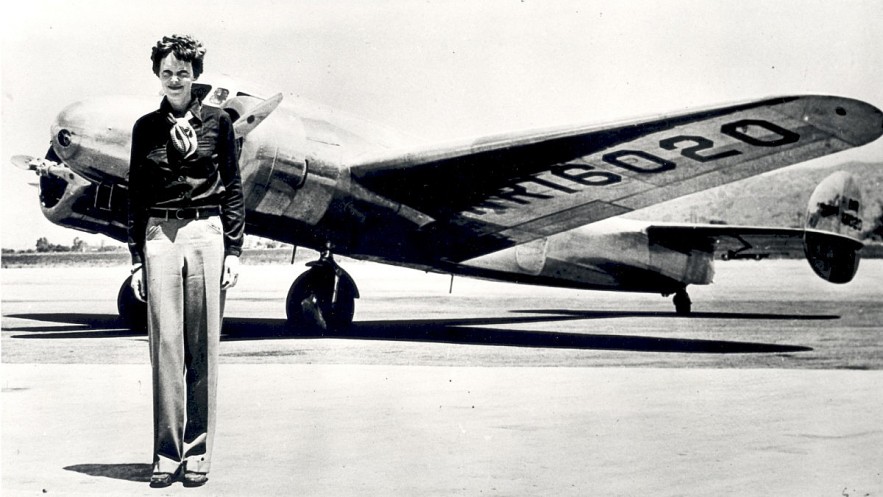 |
| Photo history |
How did Amelia disappear?
In the early hours of July 2, 1937, Amelia Earhart and her navigator, Fred Noonan, departed Lae, New Guinea, beginning one of the final stages of their illustrious circumnavigation expedition. Their next stop was Howland Island, located about 2,500 miles away in the center of the Pacific Ocean. There, the Itasca, a U.S. Coast Guard cutter, was waiting to lead the well-known aviator into a landing on the small, deserted coral atoll.
However, Earhart did not make it to Howland Island. She and Noonan were fighting cloud cover, bad radio reception, and a fast running out fuel supply in her twin-engine Lockheed Electra when they lost contact with the Itasca over the Pacific. They were never located in spite of an unprecedented search and rescue operation that involved U.S. Navy and Coast Guard ships and aircraft searching an area of the ocean covering about 250,000 square miles.
The Navy came to the official conclusion in its report at the time that Earhart and Noonan had run out of fuel, crashed into the Pacific, and perished. In January 1939, eighteen months after her disappearance, a court order pronounced Amelia Earhart legally dead. But since then, there has been intense discussion about the events of July 2, 1937, and the days that followed. Many millions of dollars have been spent looking for evidence that would reveal the truth about Amelia Earhart's fate, and a number of competing theories have been put forth.
| Her ability to fly made her a global celebrity. In 1932, she completed the first solo non-stop transatlantic flight and became the first woman to cross the Atlantic by plane. Even so, she struggled mightily to forge her own identity. To have her married name, Mrs. Putnam, replaced with Amelia Earhart, she had to write to the New York Times. She once wrote, "Tradition hampers just as much as clothing." She took seriously her role as a feminist role model; in fact, chapters in her memoir, The Fun of It, are devoted to women in aviation careers and to other women who were pioneers in the field of flight. It has been decades since her plane went down, and no one knows where it went down. The most likely answer is Howland Island, which is essentially a splinter of rock in the central Pacific Ocean, somewhere to the north of her destination. |
Theories about her disappearance
Theory 1: Open-Ocean Crash Near Destination
According to the official US position, Earhart and Noonan ran out of fuel on their way to Howland Island and crashed in the Pacific Ocean.
The US Coast Guard cutter Itasca was at Howland to assist Earhart in this pre-radar era by providing radio bearings and a smoke plume, but communication was sporadic and broken due to radio problems. According to the Itasca's radio logs, Earhart indicated she was close to the island but couldn't see it because she was out of gas. The Electra never arrived on the island.
Nauticos, a Hanover, Maryland-based company that performs deep-ocean searches and other ocean-research services, led an effort about 15 years ago to locate Earhart's plane where they believe it crashed: in the Pacific Ocean near Howland Island.
Nauticos president David Jourdan stated in 2003 that he and his colleagues had narrowed down an area of the ocean that they believe will eventually yield the plane's grave by studying factors such as Earhart's broken-up radio transmissions and what is known about the Electra's fuel supply.
"We are confident it is in the area we are searching," Jourdan went on to say. "Of course, we cannot guarantee it, because it could be on the outside edge, but we are sure it is in the vicinity."
In March and April of 2002, the company used a high-tech deep-sea sonar system to search the ocean floor near Howland for 630 square miles (1,630 square kilometers). The plane was not discovered during that expedition or a follow-up mission in 2006.
Later, in 2009, a team led by the Waitt Institute for Discovery used deep-sea robots to search a roughly Delaware-sized area just west of Howland.
Despite the fact that the expedition yielded no results, the institute's president, Ted Waitt, said in a statement that the findings "eliminate thousands of square miles from future search efforts." (Waitt works on a series of grants with the National Geographic Society, which owns a 27 percent stake in National Geographic Partners.)
Theory 2: Nikumaroro Castaway
When Earhart and Noonan couldn't find Howland, they landed their Lockheed Electra 10E on Nikumaroro Island, a speck of land 350 nautical miles southwest of Howland, according to the International Group for Historic Aircraft Recovery (TIGHAR).
The researchers' hypothesis is based on Earhart's last radio transmissions. On July 2, at 8:43 a.m., Earhart radioed the Itasca, saying, "KHAQQ [the Electra's call letters] to Itasca." We're on line 157 337." The Itasca received the transmission but was unable to locate the signal.
The "line 157 337" indicates that the plane was flying on a navigational line that bisected Howland Island from northwest to southeast. If Earhart and Noonan missed Howland, they would follow the line northwest or southeast to find it. For thousands of miles to the northwest of Howland, there is open ocean; to the southwest, there is Nikumaroro.
The last confirmed transmission from Earhart was a line-of-position radio message, but radio operators received 121 messages over the next ten days. At least 57 of those could have been from the Electra. On six of them, wireless stations took bearings.
"Four crossed near the Phoenix Islands," said Tom King, senior archaeologist at TIGHAR, in an earlier interview. "Most messages were at night when the tide was low."
The tide was especially low on Nikumaroro at the time of Earhart's disappearance, revealing a reef surface along the shore long and flat enough for a plane to land. If Earhart sent any of the 57 radio transmissions, the plane had to have landed safely.
TIGHAR researchers believe Earhart and Noonan radioed at night to avoid the scorching heat inside the aluminum plane during the day. The tide eventually pushed the Electra off the reef, and it sank or broke up in the surf. Transmissions ceased on July 13, 1937.
Other evidence suggests that Earhart and Noonan were castaways on Nikumaroro. Later that year, in 1937, a British expedition explored the island with the intention of colonizing it. A colonial officer named Eric Bevington noticed what appeared to be a "overnight bivouac." He also took a photo of the shoreline, which includes an unidentified object that TIGHAR believes is landing gear from a plane.
By 1938, the island had been colonized as part of the Phoenix Islands Settlement Scheme, one of the last expansions of the British Empire. Colonists discovered airplane parts, some of which could have come from the Electra.
Gerald Gallagher, the colonial administrator at the time, discovered 13 bones buried near the remains of a campfire in 1940. He also discovered the remains of two shoes, one for a man and one for a woman, as well as a box that once housed a sextant, a navigation device. The bones were transported to Fiji, measured, and then lost. TIGHAR researchers used modern techniques to evaluate the measurements and determined the bones could be from a woman of Earhart's size and build.
Since 1989, TIGHAR has launched 12 expeditions to Nikumaroro. During their visits to the island, they discovered a location that matches Gallagher's description of where the bones were discovered.
There is evidence of several campfires, as well as the remains of birds, fish, turtles, and clams, indicating that someone ate at the Seven Site—the name comes from the shape of the clearing around it. That person was most likely not a Pacific islander based on how the clams were opened and the fish consumed (the heads were not eaten).
Several glass bottles from the 1930s have also been discovered at the site. One of them may have even contained freckle cream, which Earhart was known to use.
A TIGHAR expedition is currently underway at Nikumaroro, with four dogs trained to detect human remains as deep as nine feet underground and as old as 1,500 years. "No other technology is more sophisticated than dogs," says Fred Hiebert, archaeologist in residence at the National Geographic Society, which is funding the dogs. "They have a higher rate of success identifying things than ground-penetrating radar."
Theory 3: The Marshall Islands Conspiracy
A third theory holds that Earhart and Noonan, unable or unwilling to locate Howland, flew north to the Japanese-controlled Marshall Islands (map), where they were captured as U.S. spies.
Some believe both pilots were killed, while others believe Earhart and possibly Noonan returned to the United States under assumed names. According to one theory, Earhart changed her name to Irene Craigmile, married Guy Bolam, and died in New Jersey in 1982.
"If she couldn't find Howland, Plan B was to cut off communications and head for the Marshall Islands, where she would ditch her plane," Rollin C. Reineck, a retired United States Air Force colonel living in Kailua, Hawaii, claimed in 2003.
According to Reineck's book Amelia Earhart Survived, Earhart ditched her plane in the Marshall Islands and returned to the United States under an assumed name for national security reasons.
The scheme, according to Reineck, would have allowed the US government to rescue Earhart in the Marshall Islands while also conducting prewar reconnaissance on the Japanese. "However, the plan failed, as many plans do," Reineck explained. He claims that when Earhart radioed that she was heading north, the message was intercepted and the Japanese kidnapped her.
Dick Spink, a high school science teacher and Earhart enthusiast, has taken up Reineck's torch in recent years, collecting oral histories from the Marshall Islands that he claims prove Earhart and Noonan landed on a tiny atoll called Mili.
"The rest of the world needs to know this," Spink said in a 2015 interview. "I heard too many people in the Marshalls tell the same story for me to dismiss it." 'She landed at Mili,' they say. "Our uncles and aunts, parents, and grandparents are all aware that she has arrived."
Spink has spent $50,000 of his own money looking for the spot where Earhart landed because the Marshallese accounts were so convincing. He believes that scientific evidence will back up the islanders' claims. (Learn more about Spink's theory on Amelia Earhart's disappearance.)
READ MORE: Facts about Planet Nine -Mystery of an Unknown Planet that holds great meanings
3. Death Valley's Moving Rocks
 |
| Photo geology in |
Mystery:
Raceway One of the longest-standing mysteries of Death Valley is located in Playa. Hundreds of rocks that appear to have been dragged across the ground are scattered across the flat surface of this dry lake, also known as a "playa." These boulders, which can weigh up to 700 pounds (320 kg), occasionally leave behind synchronized trails that extend hundreds of meters. The rocks might remain motionless for years.
Mystery solved:
Scholars have only recently discovered. It's a unique combination of water, ice, and wind, according to remote observations conducted between 2011 and 2013.
A team of (extremely patient) scientists, supported by NASA, the Scripps Institution of Oceanography, and other organizations, declared they had cracked the case in August 2014. Richard D. Norris and his cousin James M. Norris said in a statement that the rock movements happened in the wintertime under a unique set of circumstances. The dry lake bed needed to have a thin layer of water in it and have sufficiently low nighttime temperatures to support the formation of a thin layer of ice. Large floating panels of ice broke off from the ice on sunny days and moved around the rocks, leaving tracks on the desert floor as light winds pushed against them. Their study was published in the editor- and peer-reviewed journal PLOS ONE.
In 2011, the two cousins began researching sailing stones. They established the Slithering Stones Research Initiative at that time. In addition to adding fifteen of their own stones to Racetrack Playa, they set up a weather station nearby. There were GPS tracking devices attached to the extra stones.
They then observed. Their time-lapse photography setup captured rocks sliding across the playa at up to 15 feet (3-5 meters) per minute on December 4 and December 20, 2013. They became the first people in the world to witness the stones in motion after witnessing numerous additional cases of sailing stones.
| Richard Norris stated in the statement: "Science occasionally involves a degree of chance." It took us five or ten years to see any progress, but only two years into the project, we happened to be in the right place at the right time to witness it firsthand. |
| They said in their paper that watching the stones move enabled them to see the cause: The process of rock movement that we have witnessed happens when the thin, 3- to 6-millimeter "windowpane" ice sheet covering the playa pool starts to melt in the late morning sun and breaks up under light winds of ~4-5 meters/second [about 10 miles per hour], in contrast to previous theories of strong winds or thick ice floating rocks off the playa surface. Tens of meters [yards] in size, floating ice panels push several rocks at a speed of two to five meters per minute [less than two mph] along paths that are dictated by the direction and speed of the wind and the water flowing beneath the ice. |
4. The Mary Celeste
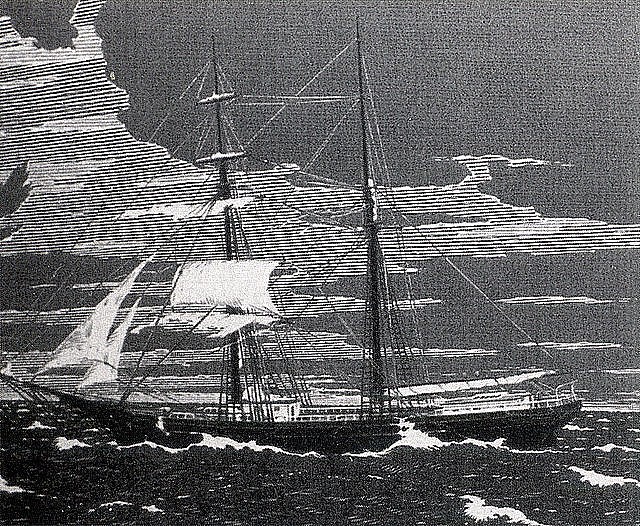 |
| Photo wikipedia |
For more than a century, people have been perplexed by the story of the Mary Celeste. After the ship failed to arrive at port, search parties went in search of it, only to find it completely empty, with no sign of a struggle. But why would a crew abandon a seemingly fine ship? What could possibly sway them?
A crew sailing for Gibraltar discovered an unassuming merchant vessel adrift off the coast of the Azores on December 4, 1872. It was completely lifeless.
The cargo and supplies on the Mary Celeste were relatively unscathed. The belongings of the previous occupants were present, the sails were furled, and the lifeboat had vanished. There wasn't much to go on with little evidence of chaos. The Mary Celeste was taken to Gibraltar for further investigation by the sailors. It was soon the subject of conspiracy theories, rumors, and lies.
The Mary Celeste was not a particularly noteworthy vessel. It was a standard brigantine, rebuilt from the wreckage of its forefather, the Amazon. The ship left New York with seven crew members after a couple of days of bad weather. It was commanded by Benjamin Spooner Briggs, a seasoned and well-respected sailor. His wife and two-year-old daughter accompanied him. They were transporting over 1,700 barrels of denatured alcohol to Genoa.
Historians believe that everything was fine until the ship's final log entry at 5 a.m. on November 25. What happened between then and the discovery of the Mary Celeste by the crew of the Dei Gratia, which was eight days behind them, was a mystery.
| Was foul play involved? Before awarding salvage payments to the crew of the Dei Gratia, Gibraltar's Attorney General, Frederick Solly-Flood, conducted an investigation. He was not, according to firsthand accounts, open-minded. He was out for blood after catching a whiff of the Dei Gratia crew's eagerness to collect the salvage earnings. He suspected foul play right away and aligned the evidence with his hypotheses. It was not uncommon for ships to be over-insured and then run aground on purpose. He suspected Captain Morehouse and his crew of stalking the Mary Celeste on the high seas, boarded the ship, and murdered Briggs and his party after discovering red stains on Briggs' sword and marks from a sharp weapon on the bow. Solly-Flood had additional theories. He wouldn't rule out a member of Briggs' crew drinking the denatured alcohol, killing everyone in a drunken rage, and fleeing in the lifeboat. Solly-Flood suspected James Winchester, one of the Mary Celeste's investors, of plotting to murder the crew. A third-party investigation eventually determined that the red stains were not caused by blood. Flood abandoned his quest, and the Dei Gratia crew received a pittance of £1,700. |
What are plausible theories?
Gibraltar's Attorney General, Frederick Solly-Flood, conducted an investigation before awarding salvage payments to the crew of the Dei Gratia. According to firsthand accounts, he was not open-minded. After catching a whiff of the Dei Gratia crew's eagerness to collect the salvage earnings, he was out for blood.
He immediately suspected foul play and matched the evidence to his hypotheses. It was not uncommon for ships to be over-insured and then deliberately run aground. After discovering red stains on Briggs' sword and marks from a sharp weapon on the bow, he boarded the Mary Celeste and murdered him and his party.
Solly-Flood had some additional ideas. He wouldn't rule out one of Briggs' crew members drinking the denatured alcohol, murdering everyone in a drunken rage, and fleeing in the lifeboat. Solly-Flood suspected one of the Mary Celeste's investors, James Winchester, of plotting to murder the crew. The red stains were not caused by blood, according to a third-party investigation. Flood abandoned his quest, and the Dei Gratia crew received only £700.
5. The Easter Island Statues
Easter Island is one of the world's most isolated inhabited islands, located more than 1,600 miles from the nearest town. Since the first explorers arrived, the island has been known for one thing: the 887 Moai, or giant statues of heads scattered along the coast.
What are the moai—and who built them?
There are currently 1,043 complete moai on the island, which are enormous statues with prominent heads made of volcanic stone. Contrary to popular belief, they have torsos as well, though many are partially or completely buried. They stand 13 feet tall and weigh 10 metric tons on average.
The majority of the statues are positioned with their backs to the sea on stone platforms known as ahu, which can hold up to 15 statues. Some moai have cylindrical red stones called pukao placed on their heads to represent a topknot of hair.
However, the true number of moai on the island is unknown because many are buried in the Rano Raraku quarry on the island's south shore, where the statues were constructed. The largest discovered moai, dubbed "El Gigante," never made it out of Rano Raraku; it stands 69 feet tall and is estimated to weigh 200 metric tons.
These statues were erected hundreds of years before the first European arrived on Easter Sunday, 1722. Polynesians, according to Van Tilburg, discovered the island around A.D. 1000 and developed advanced social, political, and religious systems that resulted in the noble moai.
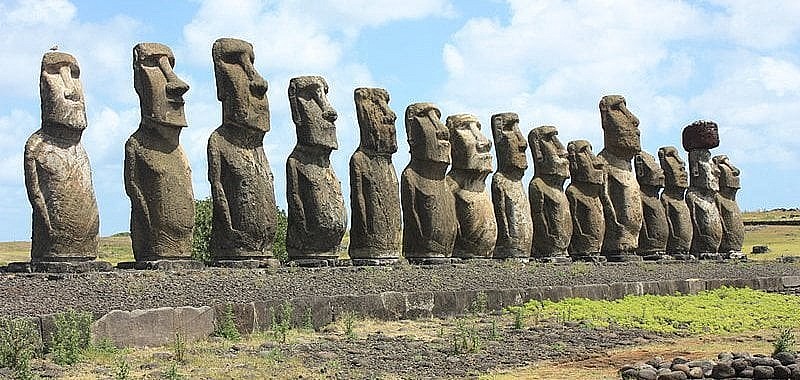 |
| Photo smithsonian |
Mystery about its location
Researchers have long been perplexed as to why the massive statues were placed where they are. According to a new study, the people of Rapa Nui, as the island is known in the local language, placed themselves near sources of humanity's most vital resource: fresh water.
Archaeologists studied the statues, or moai, and the platforms, or ahu, on which many of them stand. Around 900 years ago, Polynesian seafarers arrived on Rapa Nui, 2,300 miles off the coast of Chile.
They then built over 300 ahu and nearly 1,000 moai, which are thought to represent significant ancestors.
Explanation:
The new study's authors, who published their findings in the journal PLOS One, aimed to learn more about the ahu's creators by comprehending their distribution.
| Professor of anthropology Carl Lipo, who is one of the study's co-authors, told CNN that "that knowledge would tell us something about how the early people of Rapa Nui used the landscape and what they found important." |
An area of Rapa Nui that contains 93 ahu has been isolated by researchers from six US institutions. They examined the natural resources around the island of Hawaii, paying particular attention to freshwater sources, marine resources, and gardens with rock mulch where crops like sweet potatoes were grown.
The lack of a significant correlation was observed between the ahu's location and the existence of gardens in the vicinity, indicating that the ahu were not positioned to observe or indicate authority over these resources.
Although fresh water sources and marine resources were both discovered close to the Ahu, the researchers came to the conclusion that only the latter was noteworthy because fresh water was much less common and both usually occur in the same places.
6. The Bloop
Mystery:
A loud, extremely low frequency sound that was detected on hydrophones all over the Pacific in 1997 came to be known as the "Bloop." In fact, it was so loud that listening devices more than 3,000 miles away could hear it. The issue was that nobody knew what could have made such a loud noise, and for the following ten years, there was a lot of discussion regarding its origin.
The mystery solved: it wasn’t sea monster
During 1997, a loud, very low frequency sound was detected on hydrophones throughout the Pacific, which became known as the "Bloop." It was so loud, in fact, that listening devices over 3,000 miles away could pick it up. The problem was that no one could figure out what could have produced such a loud noise, and for the next ten years, there was a lot of debate about where it came from.
7. Mass Whale Graveyard
Builders discovered a mass graveyard in the Chilean Atacama Desert in 2011 while expanding a road, but it wasn't what they had anticipated. It was crammed with whale bones, weird dolphins with walrus faces, and sloth bones arranged side by side. After it was discovered that the fossils were between 6 and 9 million years old, it became unclear why and how so many animals would perish in one location at a height of 130 feet above sea level.
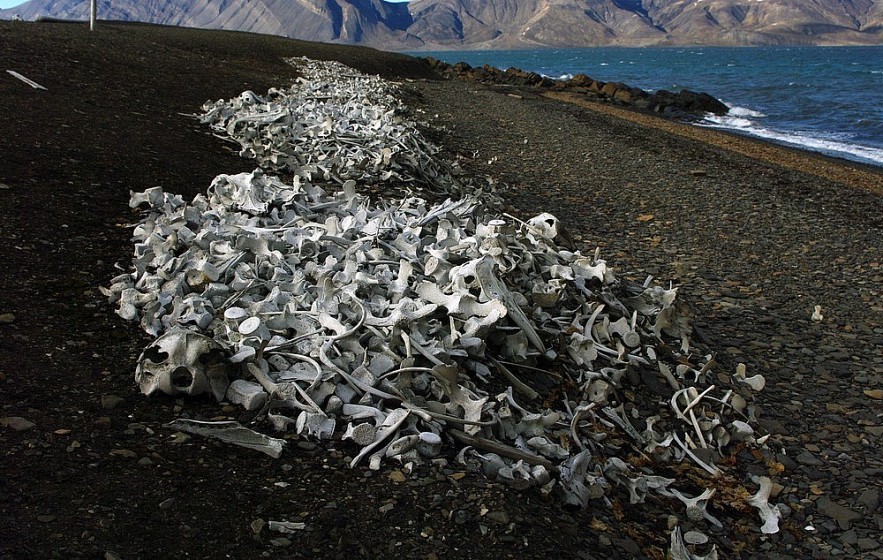 |
| Photo amazing planet |
What caused the mass whale death?
Scientists have solved the mystery of an ancient fossilized graveyard containing dozens of whales, walrus-faced dolphins, and swimming sloths.
The fossils, discovered about three years ago during a road-widening project in Chile's Atacama Desert, most likely record a series of mass strandings caused by algae blooms fed by the iron-rich sediments of the Andes Mountains, according to a study published online Wednesday in the journal Proceedings of the Royal Society B.
According to the study's lead author, Nicholas D. Pyenson, curator of fossil marine mammals at the Smithsonian Institution, about four waves of carcasses washed into what was once a placid tidal basin over a period of weeks, then were buried in sediments that accumulated over 10,000 to 16,000 years.
According to the study, the most likely explanation that encompasses all of the evidence is an upwelling of ocean water fed by iron-rich runoff from the nascent Andes, which fed massive algal blooms that poisoned the mammals through direct ingestion or inhalation or through the prey they ate.
8. Blood Falls
 |
| Photo exploresweb |
Mystery
Antarctica has much to be discovered due to its inhospitable environment and remote location. The Mcmurdo Dry Valley's blood falls are one feature that has remained a mystery ever since they were discovered. The water that is gushing out of the Taylor Glacier is a rich red color and is typically only 1.4 degrees Fahrenheit—far below the freezing point of 32!
Mystery explained
Because saltwater has a lower freezing point than pure water and releases heat when it freezes, it melts the ice beneath the glacier and allows the rivers to flow. This is why the lake beneath the glacier has an unusually salty consistency.
This indicates that the glacier is capable of supporting water flow and that it is the coldest glacier on Earth with continuous flow of water, albeit with an iron-rich appearance.
The amount of iron-rich brine in the river water was also measured as part of the study, and it was discovered that the brine content rose as the measurements approached the falls.
It was also discovered that brine content and water temperature were connected: Brine can enter the glacier through fissures of varying sizes. The concentration of brine in the center of the cracks increases as the brine (shown here in red to symbolize the amount of iron in the water) starts to freeze and the surrounding ice gets warmed by latent heat.
9. The Legend of Anastasia
Mystery
Russian Tsar Nicholas II and his wife Tsarina Alexandra had a younger daughter, Grand Duchess Anastasia Nikolaevna, who lived from June 18, 1901, to July 17, 1918. During the Bolshevik Revolution, Anastasia was taken prisoner and executed alongside her parents and younger siblings. Because so many women claimed to be Anastasia, her death was shrouded in mystery for many years.
The whole family of Russian Czar Nicholas II was killed in 1918. Many assumed that Anastasia had escaped when the body of Nicholas's teenage daughter, Anastasia, was not discovered with the other family members.
Conspiracy theories started to surface in the years after the Romanov family was executed. Many women asserted themselves as the Grand Duchess Anastasia starting in 1920.
One of them, Eugenia Smith, wrote her "memoirs" under the pen name Anastasia, in which she detailed her escape from her captors in great detail. Another was Nadezhda Vasilyeva, who arose in Siberia and was taken into custody by the Bolshevik regime; she passed away in a mental hospital in 1971.
Among the imposters, Anna Anderson was arguably the most well-known. She stated that Anastasia had been hurt but had lived, and that a guard who cared about the royal family had saved her from the basement. Anderson fought for acceptance as Nicholas' lone surviving child from 1938 until 1970. Nonetheless, German courts consistently concluded that Anderson had not presented hard proof that she was Anastasia.
Explained
When Yurovsky described the location of the bodies, it matched the burned remains that a Russian builder discovered in a forest in 2007. These were recognized as the two missing Romanovs a year later, though tests have not been able to determine which body belonged to Anastasia and which to Maria.
Since both parents and all five children have been identified through DNA testing, it has been determined that they did, in fact, pass away in July 1918. The Russian Orthodox Church canonized the entire Romanov family as passion bearers in 2000.
10. Umbrella Man
 |
| Photo economista |
Was 'Umbrella Man' Involved in the JFK Assassination?
Among the most bizarre mysteries surrounding the 1963 assassination of President John F. Kennedy in Dallas was the existence of "umbrella man." Photographs taken along the presidential route show this fuzzy figure raising a black umbrella even though the sky was clear. He was perceived by some as evidence of a plot — an advance man indicating the location of the sniper. According to Jonsson, there are those who speculate that he could be an assassin himself, possessing a poison dart gun hidden inside his parasol.
Yet in the late 1970s, when the U.S. House of Representatives revived the JFK investigation, Louie Steven Witt, a 53-year-old Dallas warehouse manager, came forward and testified that he was a "umbrella man." Although Witt's explanation was somewhat strange, it was his dislike of JFK's father, the former American ambassador to the United Kingdom Joseph P. Kennedy, whom he blamed for having supported the appeasement policies of British Prime Minister Neville Chamberlain toward Hitler. Chamberlain was known for carrying an umbrella at all times, and Witt decided to tease the president that day by waving a large, noticeable one. He claimed to have used the battered black umbrella he had brought with him as a visual aid during the hearing. When a committee staffer opened it, nothing threatening was found inside [source: Jonsson].
Witt stated, "If the Guinness Book of World Records had a category for people doing the wrong thing at the wrong time in the wrong place, I would be No. 1"
11. King Richard III's demise
One of the most well-known villains in history is the English king Richard III, who Shakespeare portrayed as a megalomaniacal, cunning hunchback. Although it has long been known that Richard lost and seemingly perished at the Battle of Bosworth Field in 1485, the manner of his death was never fully understood. Did he die in combat? And if that's the case, what became of his body, which was never located or recognized?
Explained
Ultimately, those questions were resolved after over 500 years. When an ancient grave beneath a parking lot was found in Leicester, England in 2012, DNA testing five months later verified that the bones buried there belonged to Richard III. Furthermore, forensic evidence revealed in a 2014 study published in the Lancet indicated that Richard had sustained 11 wounds, including nine blows to the skull. Researchers deduced that he had either lost his helmet or taken it off during the fight and was killed in a sustained combat with an opponent or had been attacked by several attackers due to the absence of defensive wounds on his hands or arms. Furthermore, they discovered that, contrary to Shakespeare's portrayal, Richard did not have a limp or a withered arm despite having a scoliosis, a spinal deformity.
12. How were the Pyramids built?
 |
| Photo Britannica |
The Egyptian pyramids were cited as strong evidence by proponents of the theory that extraterrestrial visitors had accelerated human civilization back in the late 1960s and early 1970s. They claimed that the enormous, multi-ton stone blocks could not have been moved by the ancient Egyptians using only their muscles and proposed the more, um, believable theory of alien anti-gravity technology.
Explained
Thankfully, physicists from the University of Amsterdam appeared in 2014 to save us from paperback pseudoscience. They deduced from the analysis of an ancient tomb drawing that a sizable labor force could have pulled the enormous stone blocks to the pyramid by using a sled and wetting the sand in their path to lessen friction. Sand would stick to one another with a tiny bit of water, forming a kind of paved road. It has been proposed by other researchers that the Egyptians employed clay as a lubricant, and it's possible that they employed multiple techniques.
13. Collapse of Mayan Civilization
One of the most bizarre societal collapses in human history has long baffled people. Why did the Maya people allow what had been a highly developed civilization to collapse into ruins in the 700s and 800s C.E., abandoning dozens of cities they had built in the Yucatan peninsula?
Some people have theorized that the ruling class was overthrown in a peasant uprising, or that rival peoples most likely defeated the Maya in combat. Some have put forth more ridiculous theories, like a UFO invasion.
Explained
However, in a 2012 study, researchers from Arizona State University, who examined archaeological data to determine the environmental circumstances during the Mayan heyday, discovered evidence to support a theory first put forth by historian Jared Diamond in his book "Collapse." The researchers found that the Maya had destroyed so much of the forests through fire and woodchips that they changed the land's capacity to absorb solar radiation, resulting in a shortage of clouds and precipitation. This made an already-existing drought worse, led to soil erosion and depletion, and ultimately failed agriculture. Everything fell apart because there was less food available, forcing laborers to flee the lowland cities in order to prevent starvation.
 Top 10 Most Mysterious People In The World Top 10 Most Mysterious People In The World There are things on earth that we have never found out, as for the list of the 10 most mysterious people in the world right ... |
 Solved Mystery: How Egyptians Moved Tons Of Rocks To Build Pyramids Solved Mystery: How Egyptians Moved Tons Of Rocks To Build Pyramids Ancient Egyptians who built pyramids moved huge blocks of rock on the desert by wetting the sand in front of a contraption built to pull ... |
 Mysteries About Leonardo's Salvator Mundi - The Most Expensive Painting in the World Mysteries About Leonardo's Salvator Mundi - The Most Expensive Painting in the World The masterpiece painting Leonardo da Vinci’s "Salvator Mundi" - once auctioned for more than $ 450 million, the most expensive in the world - is ... |

























